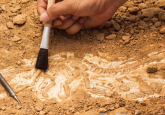The skeleton in the well: sequencing confirms gruesome 12th-century tale

A gruesome historical tale of a man who was thrown into a well has been corroborated using genetic sequencing on skeletal remains.
In 1938, the skeletal remains of a man were found at the bottom of a well at a castle in Norway. The remains were linked to a historical text from the 12th century, but little was known about the remains, which people called ‘Well-man’. Now, researchers led by Michael Martin of the Norwegian University of Science and Technology’s University Museum (Trondheim, Norway) have blended history and science to determine Well-man’s age, appearance and ancestral history.
In a passage in the Norse Sverris Saga – an 800-year-old story about King Sverre Sigurdsson – a dead body is thrown into a well at Sverresborg Castle in central Norway during a military raid in 1197 to poison the main water supply for the locals. Like many historical texts, corroborating the story can be nearly impossible; however, in 1938, bones were found in the well at Sverresborg Castle, indicating there may be some truth to the story. In 1938, little could be done with the bones bar visual analysis, but technological developments have allowed researchers to uncover more of Well-man’s story.
Using radiocarbon dating, the team confirmed that the remains were approximately 900 years old. They then sequenced samples of a tooth obtained from the skeleton and determined that the body belonged to a male who was between 30 and 40 years old at the time of death and likely had blue eyes and blond or light-brown hair.
 Slaying vampirism in enteric bacteria
Slaying vampirism in enteric bacteria
Bacterial vampirism has been identified in the Enterobacteriaceae family, revealing the link between sepsis and IBD, and highlighting new avenues for therapeutic development.
Thanks to a collaboration with Agnar Helgason at deCODE Genetics (Reykjavik, Iceland), the researchers had access to a large amount of reference data from the genomes of modern-day Norwegians, and through analyses, they could conclude that Well-man likely hailed from the southernmost Norwegian county of present-day Vest-Agder.
“Most of the work that we do is reliant on having reference data,” explained first author Martin Rene Ellegaard. “So the more ancient genomes that we sequence and the more modern individuals that we sequence, the better the analysis will be in the future.”
However, the project had limitations. To avoid contaminants from those who had handled the remains in non-sterile conditions, the outer surface of the tooth was removed. While this prevented contaminated samples, it also meant the researchers could not get data on the pathogens Well-man might have been carrying at the time of his death. Additionally, as the tooth had to be ground into a powder for sequencing, the sample can no longer be used in further tests.
This project perfectly exemplifies how archaeology and science can be blended to corroborate history. The researchers would now like to test samples from other historical figures. “The important Norwegian Saint Olaf is thought to be buried somewhere in Trondheim Cathedral,” commented . “…I think that if eventually his remains are uncovered, there could be some effort to describe him physically and trace his ancestry using genetic sequencing.”





